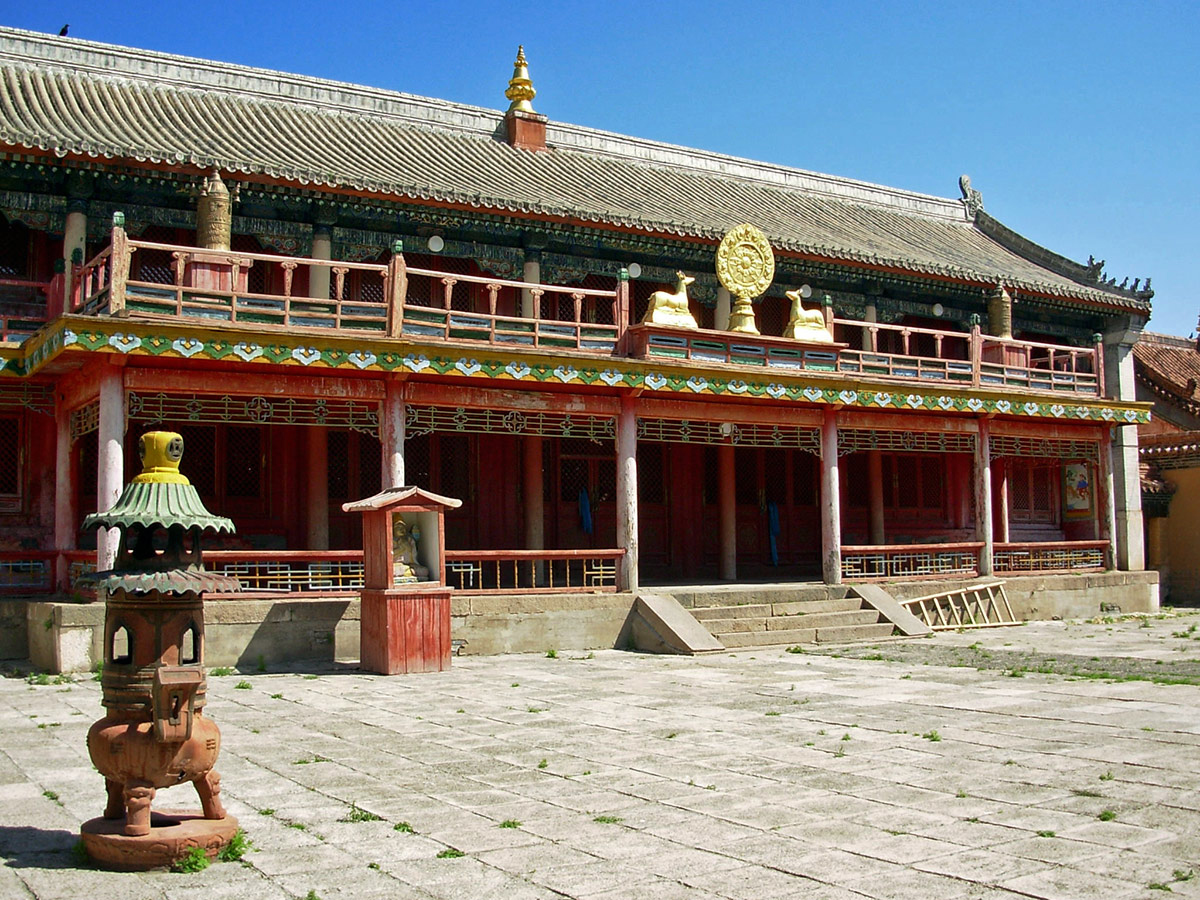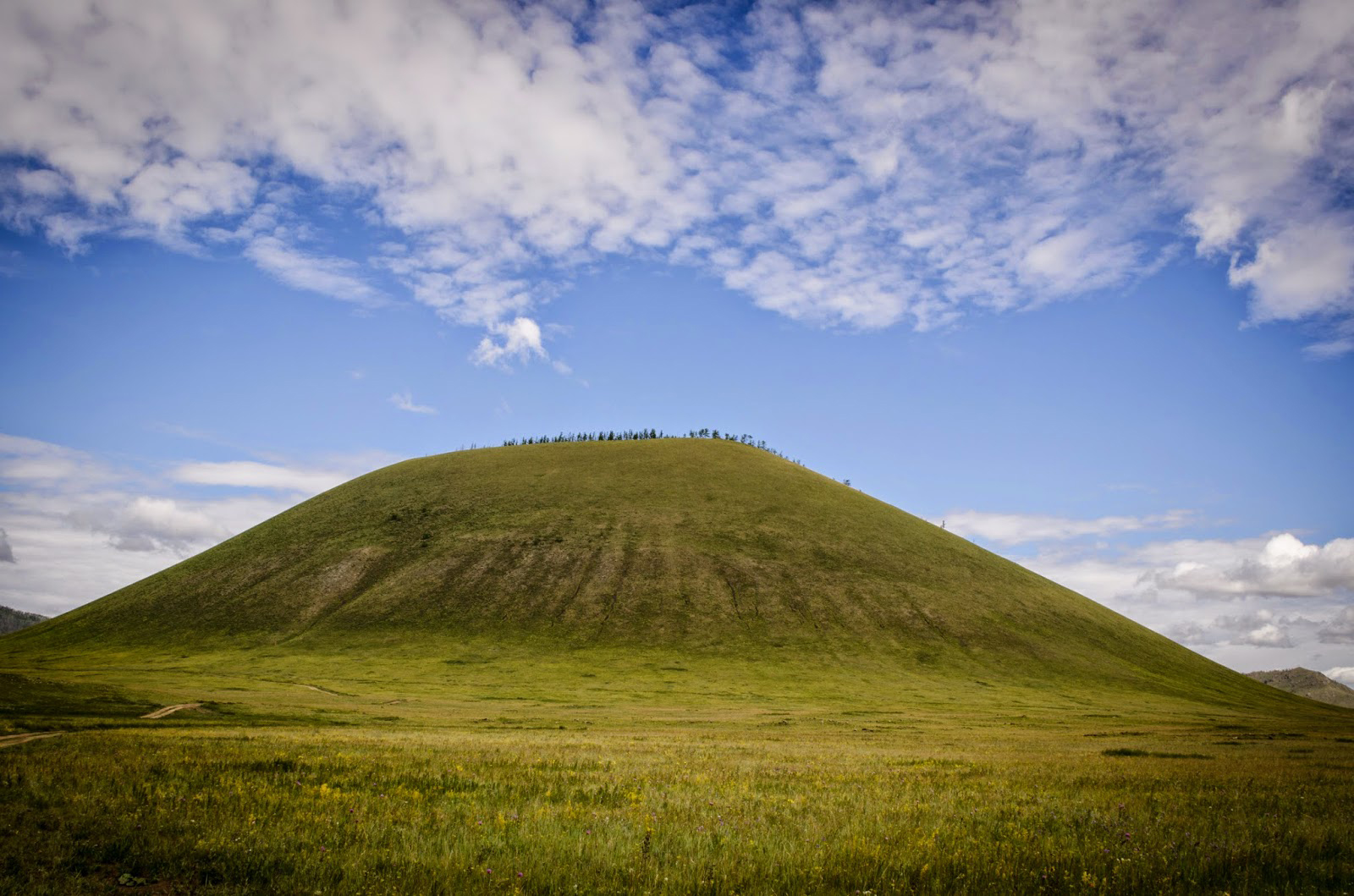
NORTHERN MONGOLIA
The highlight of Mongolia’s Northern provinces, an alpine region bordering the forests of Siberia, is the pristine Lake Khuvsgul, known as Mongolia’s “blue pearl.” Believed to be several million years old, Mongolia’s deepest freshwater lake is surrounded by dozens of small rivers and streams that empty into its waters, pristine taiga forest, and valleys and meadows rich with wildflowers. Northern Mongolia offers a chance to see a large population of reindeer. Among the nomadic peoples who inhabit Mongolia’s northern forests and steppe are the Tsaatan, members of a small Tuvanian ethnic group who have herded domesticated reindeer for centuries. The culture of these herdsmen has changed little since the Ice Age, and like many of Mongolia’s nomads, and particularly those in the north, shamanism plays an important role in their lives.
Places to visit: Pristine Lake Khuvsgul, Ancient Uushig deer stones, Amarbayasgalant monastery, Extinct volcano Uran mountain.
Activities: Horse riding, hiking, trekking, exploring pristine nature, fishing, kayaking, rafting, visiting to tsaatan(reindeer breeding) family, experiencing shamanism.
Khuvsgul Lake
.jpg) Try to imagine a 2760 sq km (1080 sq mi) alpine lake, with water so pure you can drink it. Then add dozens of 2000m (6560ft) mountains, thick pine forests and lush meadows with grazing yaks and horses, and you have a vague impression of Khuvsgul Lake, Mongolia's top scenic heart stopper. This is the deepest lake in Central Asia, with a maximum depth of 262metres and the world's 14th largest source of fresh water. Situated along the border with Russia, the lake is sacred to local Mongolians, who refer to it as 'mother'. It's full of fish and the area is home to wild sheep, ibex, bear and moose, as well as over 200 species of birds. Three separate peoples live in the area: Darkhad Mongols, Buryats and Tsaatan. It is impossible to imagine Mongolia without the uniquely magnificent and pristine land of Khuvsgul or Lake Khuvsgul. Lake Khuvsgul covers an area of 2760sq.km and exists at 1605 m above sea level. Its water is crystal clear and fresh.
Try to imagine a 2760 sq km (1080 sq mi) alpine lake, with water so pure you can drink it. Then add dozens of 2000m (6560ft) mountains, thick pine forests and lush meadows with grazing yaks and horses, and you have a vague impression of Khuvsgul Lake, Mongolia's top scenic heart stopper. This is the deepest lake in Central Asia, with a maximum depth of 262metres and the world's 14th largest source of fresh water. Situated along the border with Russia, the lake is sacred to local Mongolians, who refer to it as 'mother'. It's full of fish and the area is home to wild sheep, ibex, bear and moose, as well as over 200 species of birds. Three separate peoples live in the area: Darkhad Mongols, Buryats and Tsaatan. It is impossible to imagine Mongolia without the uniquely magnificent and pristine land of Khuvsgul or Lake Khuvsgul. Lake Khuvsgul covers an area of 2760sq.km and exists at 1605 m above sea level. Its water is crystal clear and fresh.
Uushig deer stones
A deer-decorated stones in Uushigiin uver of Khuvsgul province considered as most clearly depicted deer stones in Mongolia. These deer stones were aligned from north to south in a single column. Each stone is 3-20m distant from each other and made of tetrahedral granite stone in reddish color. A deer, an arch, a shield, a horse, a knife, the moon, the sun and a mirror figured belt were engraved on the stones.
There are around 900 hundred of these deer stones in the world, and 700 hundred of them found in Mongolia. Deer stones are ancient megaliths carved with symbols found largely in Siberia and Mongolia.The name comes from their carved depictions of flying deer. There are many theories to the reasons behind their existence and the people who made them.
Deer stones are usually constructed from granite or greenstone, depending on which is the most abundant in the surrounding area. They have varying heights; most are over 3 feet tall, but some reach a height of 15 feet. The tops of the stones can be flat, round or smashed, suggesting that perhaps the original top had been deliberately destroyed. The stones are usually oriented with the decorated face to the east.
The carvings and designs were most usually completed before the stone was erected, though some stones show signs of being carved in place.[ The designs were pecked or ground into the stone surface. Deep-grooved cuts and right-angle surfaces indicate the presence of metal tools. Stone tools were used to smooth the harsh cuts of some designs. Nearly all the stones were hand carved, but some unusual stones show signs that they could have been cut with a primitive type of mechanical drill.
Reindeer feature prominently in nearly all of the deer stones. Early stones have very simple images of reindeer, and as time progresses, the designs increase in detail. A gap of 500 years results in the appearance of the complicated flying reindeer depiction. Reindeer are depicted as flying through the air, rather than merely running on land. The antlers, sometimes appearing in pairs, have become extremely ornate, utilizing vast spiral designs that can encompass the entire deer. These antlers sometimes hold a sun disc or other sun-related image. Other artwork from the same period further emphasizes the connection between the reindeer and the sun, which is a very common association in Siberian shamanism. Tattoos on buried warriors contain deer tattoos, featuring antlers embellished with small birds' heads. This reindeer-sun-bird imagery perhaps symbolizes the shaman's spiritual transformation from the earth to the sky: the passage from earthly life to heavenly life. As these deer images also appear in warrior tattoos, it is possible that reindeer were believed to offer protection from dangerous forces. Another theory is that the deer spirit served as a guide to assist the warrior soul to heaven.
Tsaatan people&Shamanism
The Tsaatan people of northern Mongolia are a nomadic people who depend on reindeer for nearly all aspects of survival, as well as cultural, spiritual, linguistic, and economic identity. There are small ethnic Tuvanian people originated from Russian Siberia. Today just over 200 Tsaatan individuals live in the Mongolian taiga, an ecosystem characterized by larch trees, high moisture, and sub-arctic conditions. They move regularly within two main camp areas, between West and East Taiga, seeking pasture for their deer. Tsaatan maintain small herds of between 7 and 160 reindeer per family. Reindeer are milked daily, providing the staple component of the Tsaatan diet largely consisting of reindeer dairy products. They are an essential mode of transportation in the high mountain, road-less taiga. The people living in the northern part of Mongolia (Darkhad, Tsaatan, Khotgoit,) still maintain the ancient shamanic traditions. Mongolian shamanism is a practice that involves a practitioner reaching altered states of consciousness in order to encounter and interact with the spirit world, and channel these transcendental energies into this world. A shaman is a person regarded as a having access to, and influence in the world of benevolent and malevolent spirits, who typically enters into a trance state during a ritual, and practices divination and healing.
Amarbayasgalant Monastery
 Amarbayasgalant, one of the most well known and largest monasteries of Mongolia, is located in the beautiful Iven Gol River valley on the foot of Burenkhan mountain and is about 360 km of north of Ulaanbaatar. Visitors especially enjoy the magnificent art and architectural construction. The beauty, decorations and construction of the monastery have made it one of the most magnificent architectural monuments not only in Mongolia, but in the whole Asia. The monastery was established by order of Manju emperor Enkh- Amgalan Khan, to cherish and give respect to the Undur Geghen Zanabazar, the first Buddhist saint of Mongolia, for his skills, wisdom, intellect and accomplishments. 3730 kg of silver from the state fund were used to build a magnificently styled place for Buddha teaching and practice in honor of Zanabazar. After searching for a suitable place, the construction works of the monastery called “ Amarbayasgalant -a palace for God `s meditation , began in the year of red horse,1726, and was completed in the year of red dragon, 1736. During the 1937-s repression covered Amarbayasgalant Monastery and all the highly trained knowledgeable monks were executed. Also huge numbers of rare religious relics, books, sutras, thangkas and Buddhas which had been collected for 200 years, were destroyed completely. 1990 was the time when the circumstances came for Amarbayasgalant to be restored. Under Geghen's monastery Amarbayasgalant was reestablished and nowadays stands strong on it's remarkable construction, as on it's 300 year history.
Amarbayasgalant, one of the most well known and largest monasteries of Mongolia, is located in the beautiful Iven Gol River valley on the foot of Burenkhan mountain and is about 360 km of north of Ulaanbaatar. Visitors especially enjoy the magnificent art and architectural construction. The beauty, decorations and construction of the monastery have made it one of the most magnificent architectural monuments not only in Mongolia, but in the whole Asia. The monastery was established by order of Manju emperor Enkh- Amgalan Khan, to cherish and give respect to the Undur Geghen Zanabazar, the first Buddhist saint of Mongolia, for his skills, wisdom, intellect and accomplishments. 3730 kg of silver from the state fund were used to build a magnificently styled place for Buddha teaching and practice in honor of Zanabazar. After searching for a suitable place, the construction works of the monastery called “ Amarbayasgalant -a palace for God `s meditation , began in the year of red horse,1726, and was completed in the year of red dragon, 1736. During the 1937-s repression covered Amarbayasgalant Monastery and all the highly trained knowledgeable monks were executed. Also huge numbers of rare religious relics, books, sutras, thangkas and Buddhas which had been collected for 200 years, were destroyed completely. 1990 was the time when the circumstances came for Amarbayasgalant to be restored. Under Geghen's monastery Amarbayasgalant was reestablished and nowadays stands strong on it's remarkable construction, as on it's 300 year history.
Extinct volcano Uran Mountain
 Uran Mountain lies west of Bulgan city en route to Khuvsgul area. This is an extinct volcano with crater of 600 meter wide and 50 meter deep filled with small Crater Lake. Extinct volcano of Uran Mountain and nearby Togoo Mountain, now part of the 1600 hectare Uran-Togoo Tulga Uul Natural Reserve in the sum (district) of Khutag-Ondor. This mountain ranks as 4th highest mountain in Bulgan province. It is located about 60 km directly west of Bulgan city. Uran Mountain is a pretty good place to break the journey to Khuvsgul. It has been protected since 1965, and today enjoys the statue of Natural Monument. It is really fascinating mountain and home for Red deer, Argali-sheep, Wild boar, Siberian ibex and Ruddy shelduck.
Uran Mountain lies west of Bulgan city en route to Khuvsgul area. This is an extinct volcano with crater of 600 meter wide and 50 meter deep filled with small Crater Lake. Extinct volcano of Uran Mountain and nearby Togoo Mountain, now part of the 1600 hectare Uran-Togoo Tulga Uul Natural Reserve in the sum (district) of Khutag-Ondor. This mountain ranks as 4th highest mountain in Bulgan province. It is located about 60 km directly west of Bulgan city. Uran Mountain is a pretty good place to break the journey to Khuvsgul. It has been protected since 1965, and today enjoys the statue of Natural Monument. It is really fascinating mountain and home for Red deer, Argali-sheep, Wild boar, Siberian ibex and Ruddy shelduck.
Recommended


Mongolian winter is the most incredible winter that one might experience and there is plenty to see and enjoy during a winter travel. Glittering white snow, clear fresh air, sun, and little chills are the image of Mongolian winter. Taking this fan...
Duration: 3 Days / 2 Nights
Destination: Gobi - Central


All of Mongolians celebrate the Lunar New Year, which is called in Mongolia “Tsagaan Sar” or the “White Moon”. It is widely celebrated throughout the country around January or February according to the combination of Solar-...





